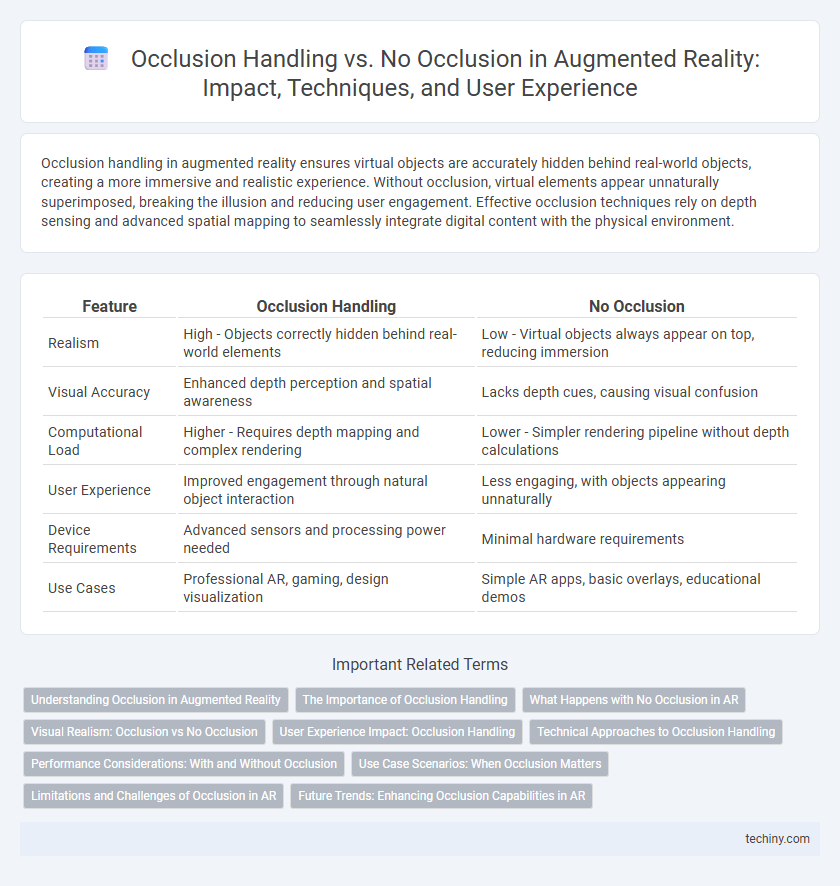Occlusion handling in augmented reality ensures virtual objects are accurately hidden behind real-world objects, creating a more immersive and realistic experience. Without occlusion, virtual elements appear unnaturally superimposed, breaking the illusion and reducing user engagement. Effective occlusion techniques rely on depth sensing and advanced spatial mapping to seamlessly integrate digital content with the physical environment.
Table of Comparison
| Feature | Occlusion Handling | No Occlusion |
|---|---|---|
| Realism | High - Objects correctly hidden behind real-world elements | Low - Virtual objects always appear on top, reducing immersion |
| Visual Accuracy | Enhanced depth perception and spatial awareness | Lacks depth cues, causing visual confusion |
| Computational Load | Higher - Requires depth mapping and complex rendering | Lower - Simpler rendering pipeline without depth calculations |
| User Experience | Improved engagement through natural object interaction | Less engaging, with objects appearing unnaturally |
| Device Requirements | Advanced sensors and processing power needed | Minimal hardware requirements |
| Use Cases | Professional AR, gaming, design visualization | Simple AR apps, basic overlays, educational demos |
Understanding Occlusion in Augmented Reality
Occlusion handling in augmented reality (AR) ensures virtual objects are correctly hidden behind real-world objects, creating a more realistic and immersive experience. Without occlusion, virtual elements appear unnaturally superimposed over physical scenes, breaking spatial coherence and reducing user engagement. Accurate depth sensing and environment mapping are crucial technologies for effective occlusion handling, enabling seamless integration of virtual and real-world layers.
The Importance of Occlusion Handling
Occlusion handling in augmented reality ensures virtual objects are realistically hidden or revealed based on their spatial relationship with real-world elements, enhancing immersion and user experience. Without occlusion, virtual content appears unnaturally overlaid, breaking the sense of depth and realism vital for applications like AR gaming, medical visualization, and industrial training. Effective occlusion handling leverages depth sensors and computer vision algorithms to accurately map environments and improve interaction between virtual and physical objects.
What Happens with No Occlusion in AR
In augmented reality, no occlusion means virtual objects do not appear to be blocked by real-world items, causing a loss of depth realism and spatial coherence. This results in virtual elements floating unnaturally over or through real objects, disrupting user immersion and interaction accuracy. Occlusion handling is crucial for creating believable AR experiences by ensuring virtual content properly integrates with the physical environment.
Visual Realism: Occlusion vs No Occlusion
Occlusion handling in augmented reality significantly enhances visual realism by accurately rendering virtual objects behind real-world elements, creating a seamless blend between digital and physical environments. Without occlusion, virtual objects appear unnaturally overlaid on the real scene, breaking immersion and reducing depth perception. Proper occlusion techniques utilize depth sensing and spatial mapping to ensure virtual content convincingly interacts with physical surroundings, improving user experience and visual fidelity.
User Experience Impact: Occlusion Handling
Occlusion handling in augmented reality significantly enhances user experience by creating more realistic and immersive interactions, allowing virtual objects to correctly appear behind or in front of real-world elements. This depth-aware rendering prevents visual confusion and maintains spatial coherence, which is critical for tasks requiring precise object placement and user engagement. Without occlusion handling, users often encounter floating or overlapping virtual content, reducing immersion and potentially causing disorientation.
Technical Approaches to Occlusion Handling
Technical approaches to occlusion handling in augmented reality leverage depth sensing technologies such as LiDAR, structured light, and stereo vision to accurately map real-world geometry, enabling virtual objects to be correctly obscured by physical elements. Advanced algorithms incorporating real-time depth buffer comparisons and segmentation models enhance the system's ability to differentiate between foreground and background layers, improving occlusion accuracy. Without occlusion handling, virtual objects incorrectly overlap real-world scenes, leading to visual inconsistencies and reduced immersion.
Performance Considerations: With and Without Occlusion
Occlusion handling in augmented reality significantly impacts rendering performance, as it requires additional computational resources to accurately detect and mask real-world objects that obstruct virtual content. Without occlusion, AR systems exhibit faster frame rates and lower latency since they bypass complex depth sensing and real-time environmental mapping, enhancing responsiveness on lower-end hardware. Optimizing occlusion algorithms or selectively applying occlusion only when critical can balance visual realism against system performance, ensuring smoother user experiences across diverse AR devices.
Use Case Scenarios: When Occlusion Matters
Occlusion handling in augmented reality (AR) is critical in use cases such as interior design, where virtual objects must realistically disappear behind real-world furniture to maintain immersion. In medical AR applications, precise occlusion ensures virtual anatomical models do not incorrectly overlay or obscure critical surgical tools or patient anatomy. Without occlusion, AR experiences can feel less believable, reducing user trust and effectiveness in professional and entertainment scenarios that require spatial accuracy.
Limitations and Challenges of Occlusion in AR
Occlusion handling in augmented reality (AR) faces significant limitations due to the difficulty of accurately detecting and rendering real-world objects that block virtual content, which can result in visual inconsistencies and reduced immersion. Challenges include the high computational cost of real-time depth sensing and object segmentation, as well as the variability of lighting and environmental conditions that impact sensor accuracy. Without effective occlusion handling, AR experiences suffer from virtual objects appearing unrealistically over or under real-world elements, diminishing user engagement and spatial understanding.
Future Trends: Enhancing Occlusion Capabilities in AR
Advancements in neural rendering and real-time depth sensing are driving the future of occlusion handling in augmented reality, enabling more precise integration of virtual objects within complex physical environments. Enhanced machine learning algorithms improve the detection and prediction of occluders, significantly reducing visual artifacts and increasing immersion. Emerging hardware innovations like LiDAR and advanced stereo cameras will further support seamless occlusion, setting new standards for AR realism and user experience.
Occlusion Handling vs No Occlusion Infographic

 techiny.com
techiny.com